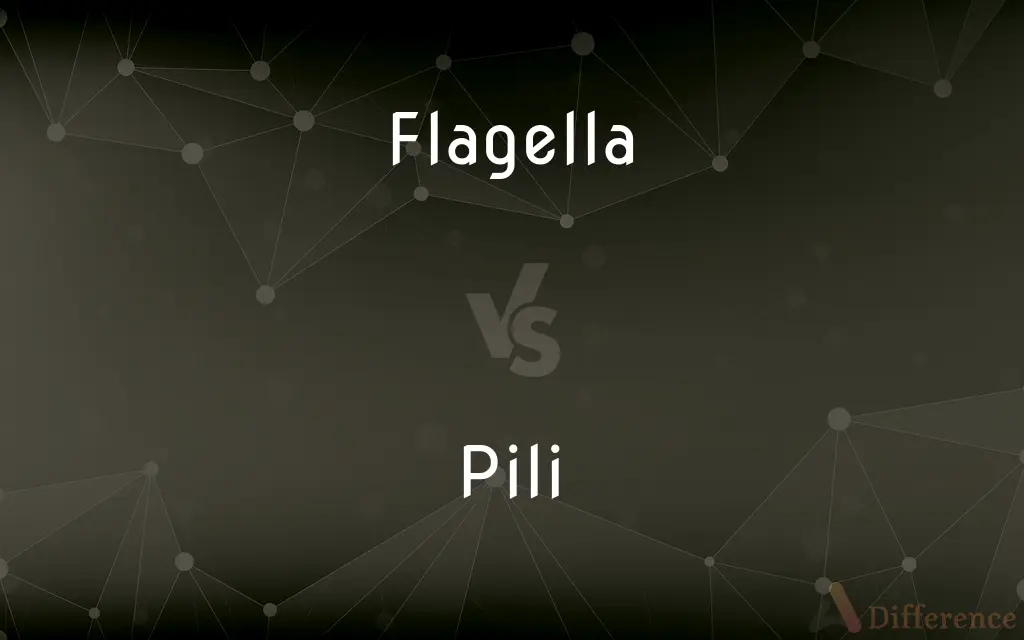Flagella vs. Pili — What's the Difference?
By Tayyaba Rehman — Published on January 7, 2024
Flagella are long, whip-like structures that aid in cellular movement, whereas pili are short, hair-like structures used for adhesion and DNA transfer.

Difference Between Flagella and Pili
Table of Contents
ADVERTISEMENT
Key Differences
Flagella are long, slender appendages that enable locomotion in certain cells. Pili, conversely, are short, filamentous projections on the surface of bacterial cells.
Flagella facilitate movement through liquid environments. Pili are primarily involved in adherence to surfaces and in the transfer of genetic material between bacterial cells.
Flagella typically rotate like a propeller. Pili often serve as bridges for DNA during conjugation.
While flagella are fewer in number, pili are generally more numerous on a cell's surface.
The composition of flagella involves a complex arrangement of proteins like flagellin, while pili are primarily composed of pilin proteins.
ADVERTISEMENT
Comparison Chart
Function
Movement
Adhesion, DNA transfer
Length
Long
Short
Number
Few
Many
Structure
Whip-like
Hair-like
Composition
Flagellin proteins
Pilin proteins
Compare with Definitions
Flagella
Long, slender, and flexible structures.
Flagella allow algae to swim through water.
Pili
Involved in bacterial adhesion and DNA exchange.
During conjugation, bacteria use pili to transfer DNA.
Flagella
Involved in locomotion in bacteria and some eukaryotic cells.
Sperm cells move due to their flagella.
Pili
Composed primarily of pilin protein.
The structure of pili is distinct due to pilin.
Flagella
Whip-like appendages aiding cellular movement.
The bacterium propels itself using its flagella.
Pili
Numerous and shorter than flagella.
A bacterial cell can have multiple pili.
Flagella
Usually fewer in number on a cell.
Some bacteria have a single flagellum.
Pili
Short, hair-like structures on bacterial surfaces.
Pili help bacteria adhere to host tissues.
Flagella
Rotates like a propeller for propulsion.
E. coli uses its flagella to navigate its environment.
Pili
Facilitate cell-to-cell interaction.
Pili play a crucial role in bacterial colonies.
Flagella
Plural of flagellum.
Pili
Plural of pilus.
Flagella
Plural of flagellum
Pili
A tropical tree, Canarium ovatum, native to maritime Southeast Asia, New Guinea and northern Australia, and cultivated in the Philippines for its nuts.
Pili
The edible nut of the tree.
Common Curiosities
Do Flagella help in bacterial movement?
Yes, flagella facilitate bacterial movement.
What are Flagella?
Flagella are long, whip-like structures used for movement.
Can Flagella be found in eukaryotes?
Yes, some eukaryotic cells have flagella.
What proteins make up Flagella?
Flagella are primarily made of flagellin proteins.
What are Pili?
Pili are short, hair-like projections on bacteria for adhesion and DNA transfer.
Are Pili more numerous than Flagella?
Yes, pili are generally more numerous.
Can all bacteria form Pili?
Many, but not all, bacteria can form pili.
How many Flagella can a bacterium have?
Bacteria can have one or a few flagella.
Are Pili used for movement?
No, pili are not primarily used for movement.
Do Flagella rotate or bend?
Flagella typically rotate like a propeller.
Are Flagella visible under a light microscope?
Flagella are generally visible under an electron microscope, not a light microscope.
What's the main function of Pili?
The main functions of pili are adhesion and genetic exchange.
What are Pili made of?
Pili are primarily composed of pilin proteins.
Do Pili play a role in disease?
Yes, pili can play a role in bacterial adhesion and pathogenicity.
Can Pili transfer DNA?
Yes, pili can facilitate DNA transfer during conjugation.
Share Your Discovery

Previous Comparison
Body Armor vs. Pedialyte
Next Comparison
Jack Daniel’s vs. BourbonAuthor Spotlight
Written by
Tayyaba RehmanTayyaba Rehman is a distinguished writer, currently serving as a primary contributor to askdifference.com. As a researcher in semantics and etymology, Tayyaba's passion for the complexity of languages and their distinctions has found a perfect home on the platform. Tayyaba delves into the intricacies of language, distinguishing between commonly confused words and phrases, thereby providing clarity for readers worldwide.
















































